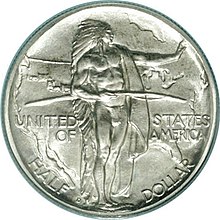United States | |
| Value | 50 cents (0.50 US dollars) |
|---|---|
| Mass | 12.5 g |
| Diameter | 30.61 mm (1.20 in) |
| Thickness | 2.15 mm (0.08 in) |
| Edge | Reeded |
| Composition |
|
| Silver | 0.36169 troy oz |
| Years of minting | 1926, 1928, 1933, 1934, 1936–1939 |
| Mint marks | D, S. Just to the left of the ground on which the Indian stands. Philadelphia Mint coins struck without mint mark. |
| "Indian side" | |
 | |
| Design | Native American standing in front of a US map |
| Designer | Laura Gardin Fraser |
| Design date | 1926 |
| "Wagon side" | |
 | |
| Design | Ox-drawn covered wagon being led west toward the setting sun |
| Designer | James Earle Fraser |
| Design date | 1926 |
The Oregon Trail Memorial half dollar was a fifty-cent piece struck intermittently by the United States Bureau of the Mint between 1926 and 1939. The coin was designed by Laura Gardin Fraser and James Earle Fraser, and commemorates those who traveled the Oregon Trail and settled the Pacific Coast of the United States in the mid-19th century. Struck over a lengthy period in small numbers per year, the many varieties produced came to be considered a ripoff by coin collectors, and led to the end, for the time, of the commemorative coin series.
Ohio-born Ezra Meeker had traveled the Trail with his family in 1852 and spent the final two decades of his long life before his death in 1928 publicizing the Oregon Trail, that it should not be forgotten. In 1926, at age 95, he appeared before a Senate committee, requesting that the government issue a commemorative coin that could be sold to raise money for markers to show where the Trail had been. The coin had originally been thought of by Idahoans, led by Dr. Minnie Howard, seeking to further preservation work at Fort Hall; Meeker broadened the idea. Congress authorized six million half dollars, and placed no restriction on when or at what mint the coins would be struck. Meeker's Oregon Trail Memorial Association (OTMA) had tens of thousands of pieces struck in 1926 and 1928, and did not sell them all. Nevertheless, most years between 1933 and 1939, it had small quantities of the half dollar coined, in some years from all three operating mints to produce mintmarked varieties, and raised prices considerably.
Collectors complained that some of the issues were controlled by coin dealers, and individual collectors had to pay high prices. Public protests followed, and in 1939 Congress ended the series. Despite the complaints, the OTMA had difficulty in selling the coins, and they remained available from the OTMA's successor organization as late as 1953. Just over 260,000 of the 6,000,000 authorized coins were struck, of which about 60,000 were melted. The US commemorative coin struck over the longest period, the Oregon Trail Memorial half dollar has been widely praised for its design.